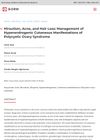TLDR The document concludes that careful evaluation is needed to diagnose PCOS correctly due to similar symptoms in other conditions, and accurate testosterone level measurement is crucial.
The document from 2013 outlines the diagnostic challenges of polycystic ovary syndrome (PCOS) due to its symptom overlap with other hyperandrogenic conditions. It states that PCOS is the most prevalent cause of hyperandrogenism, which includes symptoms like hirsutism, alopecia, acne, and menstrual irregularities. Diagnosis of PCOS follows the Rotterdam criteria, which require two out of three features: oligomenorrhea or anovulation, evidence of hyperandrogenism, and polycystic ovaries on ultrasound. The document critiques the reliability of testosterone measurement by immunoassays, which often overestimate levels, and notes that mass spectrometry is more accurate but less accessible. It also recommends using the Ferriman-Gallwey score to objectively grade hirsutism. Other conditions causing hyperandrogenism, such as congenital adrenal hyperplasia, Cushing's syndrome, and androgen-secreting tumors, are discussed. The document concludes that careful clinical judgment is essential for accurate diagnosis and that testosterone levels around 2-5 nmol/l suggest PCOS, while levels above 5 nmol/l may indicate other conditions. Misdiagnosis can lead to significant consequences for fertility and overall health.
 991 citations
,
January 2011 in “Nature Reviews Endocrinology”
991 citations
,
January 2011 in “Nature Reviews Endocrinology” The document concludes that PCOS is a complex disorder caused by both genetic and environmental factors, affecting women's health in various ways, and requires personalized treatment.
 926 citations
,
June 2010 in “BMC Medicine”
926 citations
,
June 2010 in “BMC Medicine” Polycystic ovary syndrome is a complex condition that affects women's mental, reproductive, and metabolic health throughout their lives.
 77 citations
,
June 2006 in “Best Practice & Research Clinical Endocrinology & Metabolism”
77 citations
,
June 2006 in “Best Practice & Research Clinical Endocrinology & Metabolism” The document concludes that accurate measurement of serum androgens is crucial for diagnosing hyperandrogenism.
 4809 citations
,
January 2004 in “Fertility and Sterility”
4809 citations
,
January 2004 in “Fertility and Sterility” The 2003 consensus updated PCOS diagnosis criteria and highlighted increased risks of diabetes and heart disease for those affected.
 378 citations
,
September 1998 in “The Journal of Clinical Endocrinology and Metabolism”
378 citations
,
September 1998 in “The Journal of Clinical Endocrinology and Metabolism” PCOS affects about 4% of women in the southeastern U.S. equally across Black and White populations.
 September 2016 in “Gynecology Obstetrics and Reproductive Medicine”
September 2016 in “Gynecology Obstetrics and Reproductive Medicine” Effective treatment for skin issues in women with PCOS includes oral contraceptives, antiandrogens, and other medications and procedures.
 1 citations
,
August 2013 in “Springer eBooks”
1 citations
,
August 2013 in “Springer eBooks” Birth control pills and anti-androgen medications help manage hair growth, acne, and hair loss in women with PCOS.
 3 citations
,
January 2012 in “Hanyang Medical Reviews”
3 citations
,
January 2012 in “Hanyang Medical Reviews” The document concludes that more research is needed to create suitable diagnostic criteria and understand PCOS in Korean women, and genetics may allow for personalized treatment.
 10 citations
,
January 2011 in “Skin therapy letter”
10 citations
,
January 2011 in “Skin therapy letter” Women with PCOS often have acne because of high androgen levels, and the article reviewed how to treat this type of acne.
22 citations
,
May 2006 in “Experimental and Clinical Endocrinology & Diabetes” Calculated testosterone values are reliable for assessing hyperandrogenemia in women, making direct measurement unnecessary.









